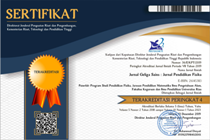DEVELOPMENT OF LEARNING MEDIA AND STUDENT WORK SHEETS ON FORCE AND WORK-ENERGY MATERIALS BASED LOCAL CULTURE TOOLS IN THE PHYSICS SCIENCE LEARNING FOR JUNIOR HIGH SCHOOL
Abstract
The purpose of this study was to examine the validity of experimental tools and student worksheets resulting from research based on traditional cultural tools on the topic of force, newton’s law, work and energy. The research method used is research and development or Reseacrh and Development. This research was conducted in physics education laboratory of PMIPA FKIP University of Riau with the subject of experiment media research based on traditional culture equipment on the topic of force, newton’s law, work and energy with data source three physics education experts and two senior teachers as validator. The data analysis used is descriptive analysis that categorizes the average validity scores of experimental tools and student worksheets on force, newton’s laws, work and energy based of traditional cultural equipment. Based on data analysis, the research results obtained the average score with good category and very good, both for the validity of the experimental tool and for the student worksheet for all aspects. It shows experimental tools and student worksheets based on traditional cultural tools are valid and can be used as experimental tools and worksheets of junior physics students.
Keywords
Full Text:
PDFReferences
Adhitama, E., Nur Aini, A & Widarwati, G., 2015. “Wayang Saintis” The Learning Media Based On Culture As An Illustration Of Scientist For Physics Teaching. 15th Indonesian Scholars International Convention, London.
Anita, S., 2009. Media Pembelajaran. UNS Press. Surakarta.
Arsyad, A., 2007. Media Pembelajaran. Raja Grafindo Persada, Jakarta.
Ashyar, R., 2012. Kreatif Mengembangkan Media Pembelajaran. Referensi, Jakarta.
Chee, T. C., 2010. Common Misconceptions in Frictional Force among Univer sity.
Creswell, John., 2010. Research Design Pendekatan Kualitatif, Kuantitatif dan Mixed, Pustaka Pelajar, Yogyakarta.
Dirjen Dikti, 2004. Pedoman Pengintegrasian Pembelajaran Berbasis Budaya dalam Pembelajaran.
Ephias, G., & Tawanda, M., 2014. Pedago gics of chemical bonding in Chemistry; perspectives and potential for progress: The case of Zimbabwe secondary education. International Journal of Secondary Education 2(1):11-19.
Zimbabwe. Erol, T., et al., 2015. The effects of classic and web-designed conceptual change texts on the subject of water chemistry. International Electronic Journal of Elementary Education 7(2): 263-280. Turkey.
Eser ÜLTAY, 2014. Context-Based Physics Studies: A Thematic Review of the Literature. Journal of Education.
Giresun, Turkey, Eser, U., & Neslihan, U., 2014. Context-Based Physics Studies: A Thematic Review of the Literature. Hacettepe Üniversitesi Eğitim Fakültesi Dergisi (H. U. Journal of Education) 29(3): 197-219.
Jasni, A., & Zulikha, J., 2013. Utilising Wayang Kulit for Deep-Learning in Mathe matics. Proceedings of the World Congress on Engineering 2013 Vol II: London.
Jonhson, Elaine B., 2012. Contextual Teaching and Learning: Menjadikan Kegiatan Belajar Mengajar Mengasyikkan dan Bermakna. Kaifa. Bandung.
Kablan, Z., & kaya, S., 2014. Preservice Teachers’ Constructivist Teaching Scores Based on Their Learning Styles. Australian Journal of Teacher Educa tion 3(12): 66-76. Kocaeli University.
Lagaudor, J., M., 2014. Cooperative Learning Approach In An Outcomes-Based Environment. International Journal of Social Sciences, Arts and Humanities 2(2): 46-55.
Philippines. Luchembe, D. et al., 2014. The Effect of Using Concept Mapping on Student’s Attitude and Achievement When Learning the Physics Topic of Circular and Rotational Motion. European J of Physics Educa tion 5(4): 10 – 29. Zambia.
Malauluan, N.E., & Masancay, D.B., 2015. Physics Instruction Utilizing CultureBased Pedagogy. Asia Pacific Journal of Multidisciplinary Research 3(4): 5058. Batangas State University.
Mayub, Afrizal, 2005. e-Learning Fisika Berbasis Macromedia Flash MX. Penerbit Graha Ilmu, Yogyakarta.
Morales, M.P.E., 2014. The Impact of Culture and Language Sensitive Physics on Concept Attainment. International Journal of Learning, Teaching and Educational Research 2(1):1-29. Philippine Normal University.
Permendikbud, 2006. Peraturan Menteri Pendidikan Nasional Nomor 22 Tahun 2006, tentang standar isi.
Nana Sudjana, 2007. Dasar-dasar Proses Belajar Mengajar. Sinar Baru, Bandung.
Rusman, 2012. Model-Model Pembelajaran Mengembangkan Profesionalisme Guru. PT Raja Grafindo Persada, Jakarta.
Salisa Nun Shiha, 2014. Pengembangan Alat Peraga Percepatan Benda untuk Menunjang Pembelajaran Fisika Pada Materi Hukum Newton Tentang Gerak. Jurnal Inovasi Pendidikan Fisika (JIPF). ISSN: 2302-4496 Vol. 3(2): 180-184.
Semih DALAKLIOĞLU, Neşet DE MİRCİ, AyşeGül ŞEKERCİOĞLU, 2015. Eleventh Grade Students’ Difficulties and Misconception about Energy and Momentum Concepts International Journal on New Trends in Education and Inter national Journal on New Trends in Education and Their Implications. January 2015 Volume: 6 Issue: 1 Article: 02 ISSN 1309-6249.
Simanek, D. E., 2008. Student Misconcep tions Induced By Teachers and Textbook.
Sitanggang, Ahmadi, 2013. Alat Peraga Matematika Sederhana untuk Sekolah Dasar, Sumatera Utara: Lembaga Penjaminan Mutu Pendidikan.
Sugiyono, 2014. Metode Penelitian Pendidikan, pendekatan kuantitatif kualitatif dan R&D. Alfabeta, Bandung.
Sukarno & Sutarman, 2014. The Development of Light Reflection Props As A Physics Learning Media In Vocational High School Number 6 Tanjung Jabung Timur. Inter national Journal of Innovation and Scientific Research 12(2): 346-355. Indonesia.
Syaiful Bahri Djamarah & Aswan Zain, 2006. Strategi Belajar Mengajar. Rineka Cipta, Jakarta.
Yigit, N., 2010. Developing presentation skills of student teachers through microteaching method. Energy Education Science and Technology Part B: Social and Educational Studies, 2, 55-74.
Yuliandari, Karina, 2012. Media sebagai Alat bantu Pengajaran Fisika. Universitas Ahmad Dahlan, Yogyakarta.
DOI: http://dx.doi.org/10.31258/jgs.5.1.32-40
Refbacks
- There are currently no refbacks.
Copyright (c) 2017 Fakhruddin Z Fakhruddin Z, Yennita Yennita, Hendar Sudrajad

This work is licensed under a Creative Commons Attribution 4.0 International License.
Jurnal ini terdaftar dan terindeks pada:
- Crossref
- Google Scholar
- Crossref
- Garuda
- Sinta
- Researchgate
- Dimensions
- Base
- Scilit
- OneSearch
- Road
- CiteFactor
- ResearchBib
- WorldCat



















